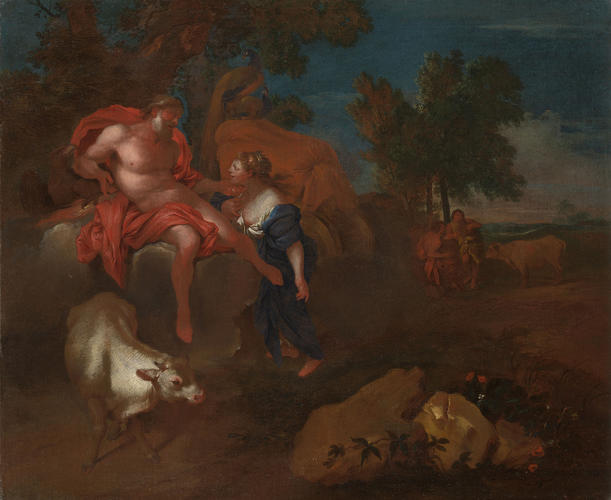Juno Seeking from Jupiter the Gift of Io Transformed c. 1637-40
Oil on canvas | 62.7 x 76.4 cm (support, canvas/panel/stretcher external) | RCIN 403235
-
In this myth from Ovid's Metamorphoses (Book 1: 588-663) the god Jupiter seduced Io, the daughter of the King of Argos, in the form of a cloud. Suspecting his infidelity, his wife Juno descended to earth in her chariot drawn by peacocks. In an attempt to conceal his wrongdoing, Jupiter hurriedly transformed Io into a white heifer. But Juno was not fooled, and feigning ignorance, she asked Jupiter for the beautiful animal as a gift. Jupiter was in no position to refuse. Juno put Io under the watch of the hundred-eyed Argus, to keep her from Jupiter's clutches. Jupiter, however, sent his messenger Mercury to recover the white heifer. With stories and the sound of his pipes, Mercury lulled Argus to sleep, and then with one blow struck off his head. In fury, Juno took Argus's eyes and set them into the tail-fathers of her peacocks, where they remain to this day.
Castiglione's painting is remarkably faithful to the details of this rarely depicted myth. We see Jupiter reclining on the cloud, his right arm resting on his eagle; Io with her gleaming white coat reclines below him; Juno's peacocks are perched on the crest of her chariot; and in the distance Mercury plays his pipes before the seated Argus, with the transformed Io shown a second time.
Castiglione was born and trained in Genoa and then travelled widely over the Italian pennisula. He had a reputation for violence and was frequently in court for assault. He was renowned for his ability to paint animals and pastoral journeys. He was a brilliant draughtsman and printmaker. This painting was given to Castiglione by Consul Smith and was bought by George III as by the artist. It has always been recognised as a work of high quality and associated with Castiglione but further assessment was hindered by its darkened condition. The painting has recently been fully conserved and cleaned revealing a painting that it is technically and stylistically very much the work of the master himself. Many more prints and drawings by Castiglione have survived than paintings and there are very paintings by him in this country so restoring this painting to Castiglione is particularly important.Provenance
Acquired in 1762 by George III from Joseph Smith, British Consul in Venice (Italian List no 228); recorded in the Coffee Room at Kew Palace in 1805 (no 19)
-
Medium and techniques
Oil on canvas
Measurements
62.7 x 76.4 cm (support, canvas/panel/stretcher external)
73.0 x 86.3 x 3.2 cm (frame, external)
Other number(s)









